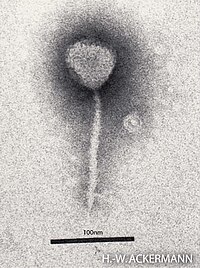
Photo from wikipedia
The RBPs of T4-like phages are gp37 and gp38. The interaction between phage T4 RBP gp37 and its receptors has been clarified by many reports. However, the interaction between gp38… Click to show full abstract
The RBPs of T4-like phages are gp37 and gp38. The interaction between phage T4 RBP gp37 and its receptors has been clarified by many reports. However, the interaction between gp38 and its receptors during phage adsorption is still not completely understood. Here, we identified phage Bp7, which uses gp38 as an RBP, and provided a good model to study the phage-host interaction mechanisms in an enterobacteriophage. Our study revealed that gp38 of phage Bp7 recognizes the outer membrane proteins (OMPs) LamB and OmpC of E. coli K-12 as specific receptors and binds with them reversibly. HepI of the inner-core oligosaccharide is the second receptor and binds with phage Bp7 irreversibly to begin the infection process. Determining the interaction between the phage and its receptors will help elucidate the mechanisms of phage with a broad host range and help increase understanding of the phage infection mechanism based on gp38. ABSTRACT Bp7 is a T-even phage with a broad host range specific to Escherichia coli, including E. coli K-12. The receptor binding protein (RBP) of bacteriophages plays an important role in the phage adsorption process and determines phage host range, but the molecular mechanism involved in host recognition of phage Bp7 remains unknown. In this study, the interaction between phage Bp7 and E. coli K-12 was investigated. Based on homology alignment, amino acid sequence analysis, and a competitive assay, gp38, located at the tip of the long tail fiber, was identified as the RBP of phage Bp7. Using a combination of in vivo and in vitro approaches, including affinity chromatography, gene knockout mutagenesis, a phage plaque assay, and phage adsorption kinetics analysis, we identified the LamB and OmpC proteins on the surface of E. coli K-12 as specific receptors involved in the first step of reversible phage adsorption. Genomic analysis of the phage-resistant mutant strain E. coli K-12-R and complementation tests indicated that HepI of the inner core of polysaccharide acts as the second receptor recognized by phage Bp7 and is essential for successful phage infection. This observation provides an explanation of the broad host range of phage Bp7 and provides insight into phage-host interactions. IMPORTANCE The RBPs of T4-like phages are gp37 and gp38. The interaction between phage T4 RBP gp37 and its receptors has been clarified by many reports. However, the interaction between gp38 and its receptors during phage adsorption is still not completely understood. Here, we identified phage Bp7, which uses gp38 as an RBP, and provided a good model to study the phage-host interaction mechanisms in an enterobacteriophage. Our study revealed that gp38 of phage Bp7 recognizes the outer membrane proteins (OMPs) LamB and OmpC of E. coli K-12 as specific receptors and binds with them reversibly. HepI of the inner-core oligosaccharide is the second receptor and binds with phage Bp7 irreversibly to begin the infection process. Determining the interaction between the phage and its receptors will help elucidate the mechanisms of phage with a broad host range and help increase understanding of the phage infection mechanism based on gp38.
Journal Title: Journal of Virology
Year Published: 2020
Link to full text (if available)
Share on Social Media: Sign Up to like & get
recommendations!